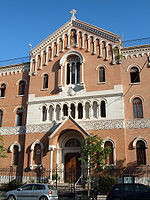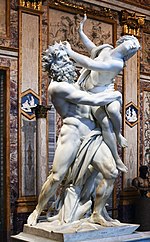Aeneas, Anchises, and Ascanius is a sculpture by the Italian artist Gian Lorenzo Bernini created c. 1618-19. Housed in the Galleria Borghese in Rome, the sculpture depicts a scene from the Aeneid, where the hero Aeneas leads his family from burning Troy.The life-sized group shows three generations of Aeneas' family. The young man is Aeneas, who carries an older man—his father, Anchises—on his shoulder. He gazes down to the side with a strong determination. Aeneas' lineage from the gods—his mother is Aphrodite—is emphasized through the lion skin draped around his body. (A lion skin commonly stands for power, and is often related to Hercules, a descendant of Zeus[2].) Behind Aeneas follows his young son, Ascanius.
The statue was made by Bernini when he was twenty years old, although it is often thought that he had help from his father, Pietro Bernini [2]. Through his father, the younger Bernini was gaining renown in the higher circles of Rome; Pietro's famous Mannerist sculptures were commissioned even by the Pope. Through some minor commissions for Pope Paul V, Gianlorenzo began to be recognized as a very promising sculptor. The Pope couldn't believe that one so young could carve such work. Those sculptures, especially the antique ones, eventually caught the attention of Cardinal Scipione Borghese, who loved arts, money and male physical beauty, and who was the most powerful man in Rome after the Pope. [6]
The sculpture is influenced by earlier works of other artists. Michelangelo's figure of the Risen Christ (in Santa Maria sopra Minerva) is held to have served as an example for the figure of Aeneas. The head of Aeneas appears to reflect Pietro Bernini's John the Baptist (Cappella Barberini in Sant'Andrea della Valle). It is thought that it has also elements derived from Raphael's fresco The Fire in the Borgo (Vatican Museum, Stanze di Borgo) and from Federico Barocci's own painted interpretation of the Flight of Aeneas (Villa Borghese)[2]. Also, the stance of the sculpture echoes another work that his father created, the Saint Matthew with Angel. Aeneas' left foot and Ascanius' right foot are standing forward, whereas in Pietro's sculpture of Saint Matthew the stance is the same, but mirrored[2].












